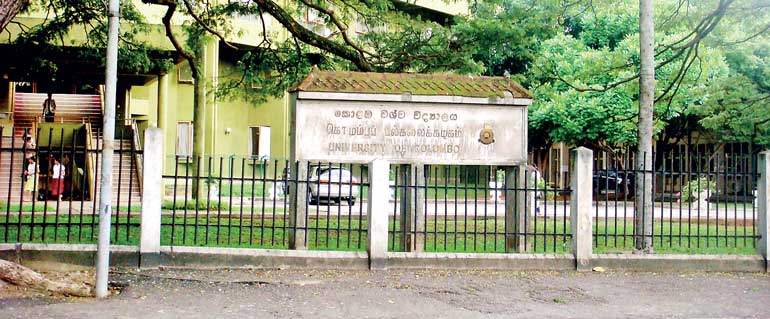Monday Nov 17, 2025
Monday Nov 17, 2025
Wednesday, 14 October 2015 00:00 - - {{hitsCtrl.values.hits}}

Universities in Sri Lanka indeed need to be drawn into the innovation economy, keeping in mind that the primary role of universities in providing the advanced human resource capacity for innovation and that a supporting industry base is essential for any initiatives to connect university HR to industry
The fourth article in an illuminating series written by W.A. Wijewardena on social market economy is about ‘universities, research institutions as catalysts of in innovation economy’. There he posits that “First, knowledge has to be created by its universities and research institutions. Then, such knowledge should be made available to prospective entrepreneurs for use in commercially viable productions known as innovation. “
In this article, I would like to counter that argument by saying that although universities are important actors in an innovation economy, they largely serve an indirect role through human capital related contributions. University research is largely about the training of human capital with advanced skills. In fact, with respect to an innovation economy, academic papers are, well, academic. The primary outputs are the researchers who were trained in the process to go deep into a topic.
There is no question that we have to support our universities to do more research, but, we need to be more realistic about the manner in which universities can contribute in innovation economy. If we do not understand the primacy of the human capital development role of universities, we run the risk of wasting money on industry-oriented research centres that are not sustainable.
(I should note here that my arguments are largely based on my knowledge of the US innovation system. I am open to ideas to the contrary from European or East Asian innovation economies.)
National innovation system concept
A linear model of innovation where universities as providers of knowledge was replaced by a systems approach in the late nineteen eighties with the national innovation systems (NIS) concept put forward by Freeman in 1987 and elaborated by Lundvall (1992), Nelson, 1993, Patel and Pavitt, 1994 and Metcalfe, 1995 and others.
The earliest definition of a NIS is possibly is as “a network of institutions in the public- and private-sectors whose activities and interactions initiate, import, modify and diffuse new technologies,” and put forward by Freeman in 1987. A later definition that elaborates the institutions further is by Niosi.
“A national system of innovation is the system of interacting private and public firms (either large or small), universities, and government agencies aiming at the production of science and technology within national borders (Niosi et al., 1993)”

Role of universities as source of human capital
Although universities are included as one of three major actors with the other two being industry and government, the exact role of universities need a closer look. As Mowery (2008) and others conclude, universities serve as a medium for circulation of knowledge through the supply of trained graduates to industry, faculty consulting and conferences and serves ‘antennas’ for adopting external knowledge through international science and technology partnerships. As Mowery further notes, an exception is perhaps in biomedical research where university hospitals and faculties of medicine are organically linked university research outputs are directly absorbed into clinical practice.
Academic publications, patents and licenses from universities play a marginal role in national innovation systems. For example, the academic share of patent and license in the USA is fraction of national output and research expenditure by industry has continued to outpace academic research by six-fold or more.
The role of research universities in the US is summarised succinctly in in the 2014 Science and Engineering Indicators report of the US National Science Foundation as follows:
“Institutions of higher education are responsible for S&E education and training and perform the majority of US basic research. In these respects, the functions of the higher education system have remained largely unchanged in recent decades”
Patenting and licensing by universities may not have contributed much in the big picture
The 1980 Bayh-Dole Act of the US congress shifted the incentive structure that governed the research and development path of federally funded inventions by allowing institutions to own inventions resulting from federally sponsored research and to exclusively license those inventions. After nearly thirty years the effect of Bayh-Dole is debated, but, there seems to be consensus that university to industry technology transfer process is not that simple.
“Over time, universities have come to a more subtle understanding of the benefits and the limitations of technology transfer. Collectively, university technology transfer offices (TTOs) have learned that patent portfolios are difficult and expensive to manage, they take a long time to mature to the point where they will deliver revenue, results are widely variable and the investment required represents a long-term commitment.” [Boettiger and Bennett, 2006]
Mowery (2008) too concludes that (1) Growth in patenting and licensing, licensing revenues are heavily concentrated in biomedical technologies (2) much of the growth in patenting & licensing would have occurred without Bayh-Dole and (3) For many US universities, financial returns are modest or negative and Staff and legal expenses for patenting and licensing offices are high.
University research centres
University research centres dedicated to specific technology fields is another mode of taking university knowledge to industry. A series of engineering research centres funded by the US National Science Foundation since early 1990s is a case in point. The author had the opportunity to evaluate some of these NSF Engineering research centres in the state of Ohio in late 1990s. The research centres received money from the NSF on the basis that NSF would give funding for 3-5 years and the industry partners would pick up the costs after. The sustainability of these centres beyond the government funding period very much depended on the particular industry of focus, with some being more successful than other. The US NSF continues fund such university-industry research centres, but, cost benefits of such centres for developing economies need to be carefully evaluated, because for success these centres depend on large outlays for both capital and recurrent expenditures.
For developing economies initial commitment from industry with more industrial control could be a more viable model.
Industry parks
Sri Lanka Institute of Nanotechnology (SLINTEC), an industry led industry park located in Homagama could be a more sustainable model for Sri Lanka. Its initiation was reported by Sunday Times in 2006 as follows:
“A Cabinet paper has been prepared in consultation with the two Professors – Prof. Gihan Ameratunga, Head of the Nanotechnology Department, University of Cambridge, UK and Prof. Ravi Silva, Head of the Advanced Technology Institute of Surrey University, UK to promote Nanotechnology in Sri Lanka, by establishing a centre for Nanotechnology in the island, Minister of Science and Technology Prof. Tissa Vitharana said.”
The two expatriate scientists were instrumental in pushing the initiative to secure funding from Diaolog, Hayleys, Lankem, John Keells, Loadstar and MAS Holdings as and Virtusa as beneficiary partners and, of course, contribution from the Sri Lankan government to establish the centre.
Dr. Ajith de Alwis in his FT article titled ‘Being bold: Triple hexagons for triple convergence’ cites SLINTEC as a bold experiment that bore fruit. “I remember the initial design drawing where the symbolic three hexagons and the tower were shown majestically inside a land mass which was to be the iconic park. Today at Homagama the design has been realised to a certain degree. One hexagon proudly stands housing the Nanotechnology Research and Development Wing and boasts of having certainly the most advanced as well as varied high-end equipment present in Sri Lanka under one roof.” (Notes: The other two hexagons were to be biotechnology and IT).
The science expertise base of SLINTEC is worth of analysis. A cursory analysis is presented here. The 14 member board is represented by one expatriate academic scientist, 3 government representatives, one independent and nine industry representatives. The leadership team includes two strong local academics and an expat academic as the chief research scientist. The contribution of universities is best illustrated by the team of scientist of whom seven received their received their BSc training in local universities and two at the Institute of Chemistry, a non-profit private entity. Two of the nine received their doctoral training in Sri Lanka and other seven from USA, Sweden and UK.
Alwis draws on examples of Biopolis and Fusionpolis industry parks in Singapore to exhort policy makers to be bold again and venture into industry parks devoted to Biotechnology, IT and cognitive Science. Given the limited resources we have even for forensic analysis of DNA, we may not be ready from industry side to venture into new areas, except perhaps in IT.
Research-based post graduate education in Sri Lankan universities
One of the most established modes of university contribution to innovation is through training of students by way of post-graduate degree programs. The research strength of a university is indeed judged by the size of its post-graduate programs. For example, in the earlier versions of Carnegie classification of university, a research university is defined is one producing 20 or more doctorate degrees a year.
In a study on research and research training Upali Samrajeewa (2003) noted that Sri Lanka produced 2.5 PhDs per year on average from 7 universities during the 1991-2000 time period. Unfortunately the study was not updated for the 2000-2010 period. But it is unlikely that the rate has improved much, because more recently, rightly or wrongly, the focus has been on sending students abroad for post-graduate study.
Concluding remarks
Universities in Sri Lanka indeed need to be drawn into the innovation economy, keeping in mind that the primary role of universities in providing the advanced human resource capacity for innovation and that a supporting industry base is essential for any initiatives to connect university HR to industry.